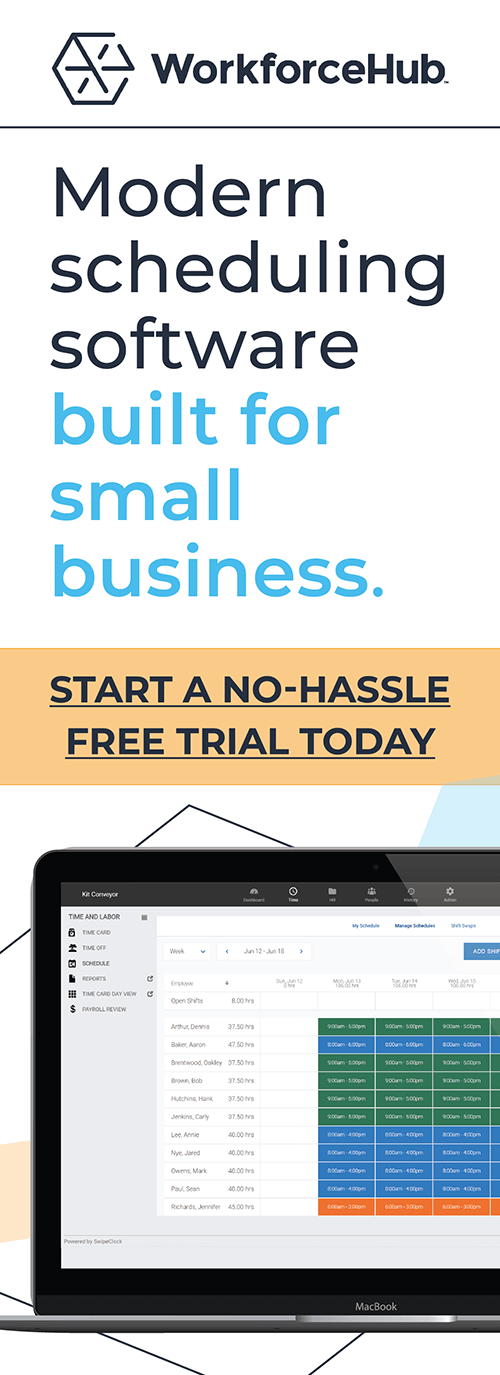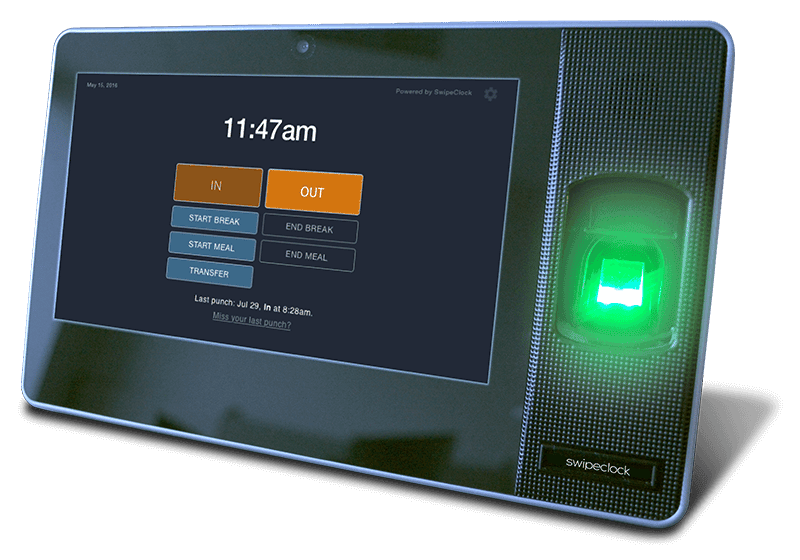Destructive Employee Absenteeism? Improve Your Attendance Tracking.

Updated September 19, 2022
Attendance tracking is critical for identifying and reducing employee absenteeism.
The impact of absenteeism doesn’t get the attention it deserves. Even one employee with an issue can create headaches for everyone. But it’s not just an annoyance. It has serious consequences for your business.
Employee Attendance Issues
- Arriving late
- Frequently calling in sick
- Failing to attend meetings
- Missing appointments
- Longer-than-authorized breaks
- Leaving work before the shift ends
- Failing to perform job duties while at work
How do attendance issues affect my business?
The most obvious problem is that co-workers have to pick up the slack. But the negative effects don’t end there.
Employee attendance and morale
When an employee has a chronic attendance problem, it reduces workforce morale – for both co-workers and managers. Co-workers become resentful and frustrated. The employee with the problem can’t keep up to speed. It slows progress on team projects.
Productivity
An employee who misses work frequently is usually a poor performer. Success and productivity require not only physical presence but a commitment to the company’s goals.
Profitability
Out-of-control employee absenteeism reduces revenue. Hiring a temp or paying for overtime adds up fast and directly affects the bottom line. Clearly, smart business owners are proactive about preventing attendance problems.
Customer service
Employees who interact directly with customers are the face of the company. If their job requires ongoing communication (as with an account representative, for example), frequent absences harm the client relationship. When co-workers fill in, they don’t have the background and context to serve the customer effectively. Clients get impatient when they are passed from one rep to the next. Each successive agent needs to get up to speed which reflects poorly on the organization. Not only can it prevent upselling and repeat business, frustrated customers may leave negative online reviews which live forever!
Team unity
Effective work teams require effective team members. Success depends on competence and dedication. One weak link can have an outsized impact.
Company culture
When poor attendance is tolerated, it suggests a culture that lacks accountability. No organization wants to go down this road. It might seem counterintuitive, but it suggests that employees’ individual contributions aren’t integral to success. Hold employees accountable because it underscores the importance of their efforts.
The Cost of Employee Absenteeism
According to the Bureau of Labor Statistics, over seven million U.S. workers have an illness-related absence per month.
The cost of absent employees is manifest in many ways including:
- Higher cost for replacement workers as manifest in temporary employees, overtime wages, or managers subbing in a shift.
- Poor quality of service or goods resulting from fatigue or understaffing
- Reduced productivity
- Excessive manager time and administrative expense
- Safety issues
- Poor morale
Completely eliminating absenteeism is not feasible. In fact, often another problem presents itself when absenteeism is overmanaged: presenteeism. Presenteeism is when employees work despite health or other issues and their productivity drops. It can cause illnesses to spread through the office. Both absenteeism and presenteeism cost employers in money and in lost productivity.
What Causes Employee Absenteeism?
Depression is the primary cause of unexcused absences but there are many other reasons. These include workplace harassment, burnout, stress, and low engagement. As well as childcare or elderly care issues, illnesses, injuries, and chronic health problems such as asthma or PMS. In addition, some employee miss work to hunt for another job.
Let’s break it down:
Depression
The leading cause according to the National Institute of Mental Health. Depression can be a result of other life stresses or health conditions and can piggyback with other causes of excessive absenteeism.
Workplace bullying or harassment
Employees are more likely to call in sick to avoid a negative situation where they are harassed or bullied by coworkers or a manager.
Burnout and low morale
Employees with heavy workloads and stressful meetings or constant deadlines are at higher risk of burnout. Additionally, feelings of being unappreciated decrease morale.
Disengagement
Employees who disengage with their employment are much more likely to be absent than engaged employees. They lack the motivation to go to work and as a result, smaller excuses become a “great reason” to miss work.
Stress
Both personal and professional stress contributes to absences. Employees approaching a wedding or going through a divorce often have higher levels of stress. Additionally, the health or welfare of family members or close friends can increase employee stress.
Illness
Sickness, illness, and medical appointments are the most commonly reported reasons for missing work. They are not always the actual reason for an absence. Flu and cold season often bring spikes in worker absences.
Injuries
Accidents and acute injuries are a common reason employees miss work. Acute injuries such as chronic back pain can also be a common cause.
Childcare and eldercare
Employees often miss work due to childcare changes when normal arrangements fall through. This could be caused by a sick child, a school holiday or snow day, or a sick caregiver.
Job hunting
Employees may call in sick to work when they have job interviews or are working on their resumes.
The good news?
There are many actions that you can take to improve your absence management. These steps have a side benefit of reducing employee turnover and increasing employee retention.
Smarter scheduling
Flexible scheduling is a valuable benefit. Job seekers place flexible scheduling as the most important benefit after health insurance. As a result, employers who offer some flexibility in scheduling tend to retain employees better and maintain a higher morale.
Compliance also comes into play here. Many local scheduling laws require employers to take employee scheduling preferences into account. These laws force what could be a beneficial practice for employers, especially those not forced into compliance.
Employers can offer flexible scheduling by allowing employees to input their schedules and preferred times to work into the employee portal. Managers can then schedule around employee preferences. Another option is to give employees even more flexibility by setting guidelines such as the required number of hours. Managers can require that employees work specific periods, but allow the rest of the shift to be determined by the employee.
For example, your employees may need to be to work for a department meeting at 11:00 am, but some may choose to start work at 5:00 AM and be done after the meeting, while others may show up at 10:00 am and work until 7:00 pm. This gives employees the ability to better manager personal obligations and stress factors. It also provides a way for employees to work during their peak performance period, which optimizes productivity.
Let’s recap the benefits:
- Provides employees flexibility in dealing with life stresses and family obligations
- Allows employees to work during their peak performance times
- Flex schedules are the #1 employee benefit after health insurance
- Employees can input preferred schedules and submit for manager approval
Return to Work Interviews
After an employee has been absent, a return to work interview is a great way to connect with your employee. It can be a formal interview or a short interview, depending on the length of the absence.
During a return to work interview, you can welcome the employee back and express concern for what caused the absence, whether it is illness or a family matter.
Additionally, you can update your absent employee on project status, customer requests and other issues. It also provides a way for employees to know that absences are noticed.
Employees can explain in person what caused their absence. This can foster greater honesty and openness. Managers can then provide support for employees and be apprised of potential future needs of the employee that will allow them to better support the employee.
Health and Wellness Programs
Many employers are adopting health and wellness programs to manage their absenteeism rate. These programs can include “points” or refunds for employees who participate in exercise or yoga plans, maintain up-to-date preventative care, or participate in health wellness education.
It can also include benefits such as providing a free or on-location flu shot to any employees who wish to take advantage of it.
Wellness programs can include educating employees about how to better manage chronic health conditions such as back pain, asthma, depression, or gastroesophageal problems. Healthier behavior can lessen the impact of chronic illnesses.
Wellness programs can have another advantage: in addition to helping to mitigate preventable absences, they can also reduce healthcare costs for employers.
Absenteeism vs Presenteeism
Wellness programs also help to combat presenteeism. Employees who come to work with chronic pain or other health issues are able to better manage those problems through employer-provided health resources. That increases the productivity of present employees and helps them to be absent due to illness fewer times.
- Employees with better health behaviors have lower rates of absenteeism
- Employees who can control their stress have lower absenteeism
- Employees with healthy cholesterol, blood pressure, and glucose have lower absenteeism
- Employees with a healthy body weight have lower absenteeism
- Employees with better health habits perform at higher productivity
Time and labor tech
Flexible scheduling, remote work, wellness programs, and return-to-work interviews are all helpful tools for managing employee absences. But, without good software, those tools become less effective.
A good time and labor platform provides a way for managers to track unscheduled absence, quickly plan for employee substitutions, and communicate with employees. Managers can see which employees are approaching overtime limits, which ones are on reduced schedule leaves, and which ones have requested extra hours. Additionally, employees can submit preferences to managers and request shift swapping, which makes replacing a sick employee even easier.
Measure employee absences and spot trends
The ability to accurately measure employee absences is critical to identifying or addressing any chronic issues in your company. HR data is centralized, stored, and secure for easy access.
Data makes it easier to manage specific employees with chronic absences and take away the emotional bias that often exists in employee-employer relationships.
Absence data can be collected across departments, locations, or for specific employees. Use the data to compare to other organizations in the industry.
Plan effectively for absenteeism
Build a plan for employee absences. Use your employee policy as a guide. Incorporate triggers and alerts into the system so managers are alerted when absence thresholds are triggered.
Alerts help managers to realize that absence triggers are occurring and to effectively deal with them in a timely manner.
Don’t forget that part of your absence management plan needs to include information around FMLA and other local leave laws. Otherwise, managers that pressure employees to come to work put the company at risk. Likewise, managers should be constantly aware of any language an employee uses that would indicate a leave due to FMLA reasons or scheduled absences that are protected by other laws.
Attendance Tracking Helps You Spot Attendance Problems
Busy managers need hard data to understand the scope of attendance problems. This is especially true if you have mobile or offsite workers. The only way to prevent or correct problems is to:
- Create a compliant, progressive attendance policy
- Track attendance to understand the situation
- Treat all employees equally under the policy
Employee Attendance Tracking Made Easy
It’s never been easier or cheaper to accurately track employee attendance.
WorkforceHub is an all-in-one time and labor solution for small businesses. Employees can clock in with a web browser, hardware clock or mobile app. WorkforceHub captures punches in real time and continually updates the employee’s virtual timecard.
The scheduling module in WorkforceHub prevents schedule confusion by making it easy for managers to create and publish schedules well in advance. This is one of the easiest ways to reduce absenteeism.
WorkforceHub tracks Paid Time Off as well and syncs with timecards and schedules. Your managers won’t miss spreadsheet PTO tracking.
As a recap, here are the key time and labor features in WorkforceHub:
- Intelligent time tracking
- Scheduling
- Time-off management
- Time-off accruals
- Payroll export
- Mobile apps
- Employee notifications
- Manager notifications
- Overtime management
- Holidays
- Break management
- Buddy punching prevention
Final Thoughts
Employee absence management is vital to your organization’s productivity. But, it isn’t about pressuring employees to come to work. Instead, absence management includes providing employers and managers with the tools to effectively reduce absences and to cover absent shifts.
See also:
- Employee Time Clock Hardware
- HRMS Success: How to Manage Human Resources
- Best Employee Time Tracking System to Replace Punch Card Clock
- Predictive Scheduling Laws: What You Need to Know
- 7 Ways an HR Portal Can Transform Your Business
- 5 Practical Tips for Managing Your Hybrid and Onsite Workforce
- 8 Employee Time Tracking Tools for High Performing Businesses
Simplify HR management today.
Simplify HR management today.
The Importance of Facial Recognition Time Clocks for Small Businesses
Updated April 17, 2024 A facial recognition time clock is no longer a luxury. Advanced biometric clocks are a must-have for today’s workplaces. A facial recognition time clock is the best technology for tracking employee time. It solves a multitude of problems employers are facing with their workforces. What is a Facial Recognition Time Clock?…
Read MoreEmployee Time Clock Hardware: Which is the Best?
Updated April 9, 2024 What is employee time clock hardware? An employee time clock is a hardware device for tracking work time. To use it, employees ‘punch’ in/out or ‘clock’ in/out. The term ‘punch in’ stems from early employee time clock hardware that required a physical card. With a traditional mechanical time clock, the process…
Read More





